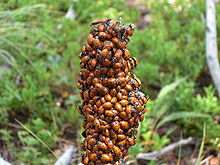- Hippodamia convergens
-
Convergent lady beetle Yosemite National Park Scientific classification Kingdom: Animalia Phylum: Arthropoda Class: Insecta Order: Coleoptera Family: Coccinellidae Genus: Hippodamia Species: H. convergens Binomial name Hippodamia convergens
Guérin-Méneville, 1842Hippodamia convergens, commonly known as the convergent lady beetle, is one of the most common lady beetles in North America and is found throughout the continent. Aphids form their main diet and they are used for the biological control of these pests.
Contents
Life cycle
The female lady beetle lays 200 to 300 eggs over several months during spring and early summer. The eggs are small and spindle-shaped and are laid near the prey in upright batches of fifteen to thirty eggs. The larvae are dark and somewhat alligator-shaped.[1] Once the larvae begin feeding, they grow quickly and moult four times over a period of up to a month. The pupal stage lasts about a week and mating takes place soon afterwards. If there is an abundant supply of aphids the female may start laying within about a week of mating, but if the supply is scanty, she may wait for up to nine months.[2]
Biology
The first larvae that hatch in each batch may start by eating the unhatched eggs. This may provide energy for the larvae before they find any aphids. Feeding takes place when a larva bites a hole in the body of an aphid and sucks out the juices. The lady beetle larva then pumps fluids back into the aphid body and sucks the fluid out again several times in order to extract the maximum amount of nutrition. The fourth-instar larva may consume about fifty aphids per day and the adult lady beetle may eat about twenty. When aphids are scarce, the adults can eat honeydew, nectar and pollen or even petals and other soft parts of plants.[3] However they must consume aphids in order to reproduce.[4] In the western United States, these beetles may spend up to nine months hibernating in large aggregations in mountain valleys, far from their aphid food sources. In spring, the adults spread out and search for suitable sites to lay their eggs where aphids are plentiful. This dispersal trait is especially marked in this species as compared to other lady beetles.[1]
References
- ^ a b Cornell University
- ^ Balduf, W. V. (1935). The Bionomics of Entomophagous Coleoptera. St. Louis, MO: John S. Swift Co..
- ^ Hagen, Kenneth S. (1960). "Biological Control with Lady Beetles". Plants and Gardens: the Brooklyn Botanic Garden Record 16 (3): 28–35.
- ^ Haug, G. W. (1938). "Rearing the Coccinellid Hippodamia convergens on Frozen Aphids". Annals of the Entomological Society of America 31 (2): 240–248.
External links
Categories:- Coccinellidae
- Biological pest control agents
- Beetles of North America
Wikimedia Foundation. 2010.


